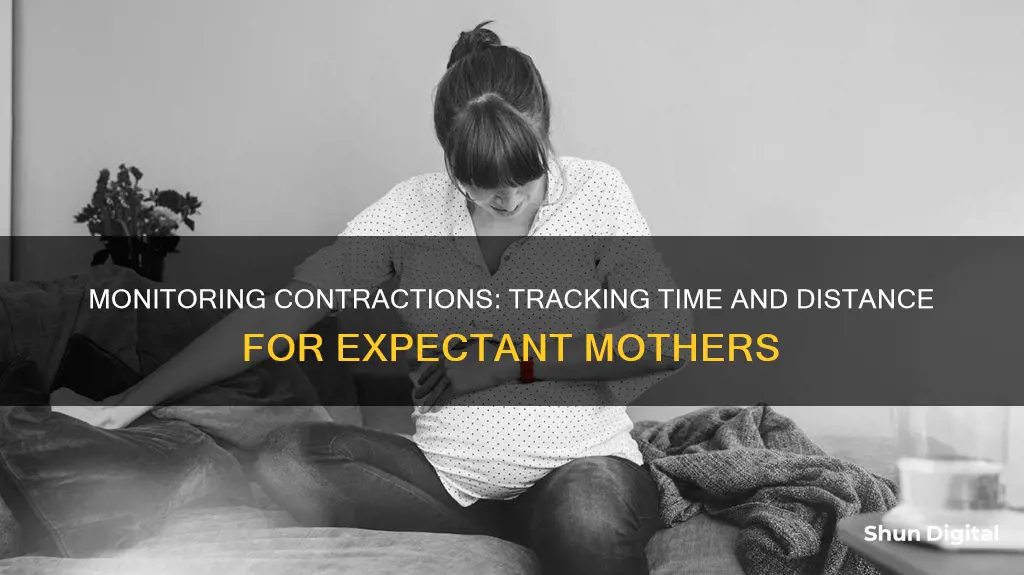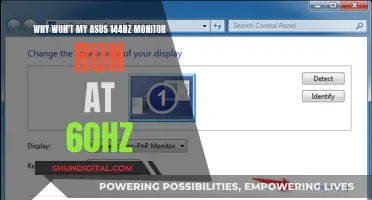
Monitoring contractions is important to assess the health of the foetus, detect early foetal distress, and identify abnormalities in contractions so that doctors can take appropriate action. An electronic contraction monitor displays two charts: one showing contractions and the other depicting the baby's heart rate. The X-axis on both charts indicates time in minutes, while the Y-axis on the baby's chart shows BPM (beats per minute) and the Y-axis on the mother's chart indicates contraction intensity. The lines on the graphs move from right to left, with recent information on the right. Continuous monitoring is common and involves external or internal monitoring, or a combination of both. Less common is intermittent monitoring, which is often used for low-risk pregnancies.
| Characteristics | Values |
|---|---|
| What the monitor shows | How strong the contractions are, how long they last, and how far apart they are |
| What contractions look like | Little mountains or peaks |
| X-axis | Time in minutes |
| Y-axis for baby's heart rate | Beats per minute |
| Y-axis for contractions | Millimetres of mercury (mmHg) |
| Normal uterine contraction basal tone | 8-10 mmHg |
| Contraction intensity | Maximum amplitude of contraction regardless of basal tone |
| Frequency of uterine contractions in 10 minutes | Latent phase: average of 3 contractions in 10 minutes with intensity of 40 mmHg |
| Frequency of uterine contractions in 10 minutes | Active phase: average 3-4 contractions/10 minutes with intensity of 60-100 mmHg |
| Frequency of uterine contractions in 10 minutes | When the cervix is nearly full: average 4-5 contractions/10 minutes with intensity of 80-100 mmHg |
| Uterine contraction & resting time | Latent phase: contraction time is 20 seconds, resting time is 3-4 minutes |
| Uterine contraction & resting time | Active phase: contraction time is 30-40 seconds, rest time is 2-3 minutes |
| Uterine contraction & resting time | When the cervix is nearly full: contraction time is 40–50 seconds, rest time is 1 minute - 1 minute 30 seconds |
What You'll Learn

Continuous vs. intermittent monitoring
Fetal monitoring is a way for healthcare practitioners and nurses to keep track of a baby's heart rate during labour. This is done to check how the baby is doing and to see how it is tolerating the mother's contractions.
Continuous Monitoring
Continuous monitoring provides ongoing, real-time data on the fetal heart rate and uterine activity throughout the entire birthing process. It is usually carried out in high-risk pregnancies and other urgent situations. It can be done externally or internally. External monitoring involves two sensors that measure the fetal heart rate and the mother's uterine contractions. These sensors are placed on the mother's abdomen, restricting her movement. Internal monitoring is less common as it carries an increased risk of infection. It involves an intrauterine pressure catheter to measure contractions and a fetal spiral (scalp) electrode to monitor the heart rate.
Intermittent Monitoring
Intermittent monitoring, also known as auscultation, documents the fetal heart rate at specific intervals. This might happen every 15 to 30 minutes in the active phase of the first stage of labour, and every five to 15 minutes during the second (pushing) stage. Intermittent monitoring is generally considered to be more appropriate for low-risk pregnancies. It can be done with an electronic fetal monitor, a handheld Doppler device, or a fetoscope.
There is no clear answer to this question. For low-risk pregnancies, experts agree there is no need for continuous monitoring. Periodic monitoring (intermittent auscultation) is just as effective and is associated with fewer c-sections and forceps deliveries. However, some studies have found that babies may be marginally safer when monitored continuously.
What to Expect
If you are giving birth in a hospital, it is likely that you will be hooked up to a contraction monitor. Every time you have a contraction – even if you have an epidural and can’t feel them – it will show up on the screen as a little mountain. The monitor's screen will show how strong your contractions are, how long they are lasting, and how far apart they are.
Removing OSD from Your ASUS ROG Monitor
You may want to see also

How to read a contraction monitor
If you're giving birth in a hospital, your doctor will probably use a continuous fetal monitor to show your contractions on a screen. This will be placed near your bed and will likely be quite loud. The monitor will show how strong your contractions are, how long they're lasting, and how far apart they are.
The monitor will display two separate graphs, one for your baby's heart rate and one for your contractions. The graph showing the baby's heart rate is normally displayed above the one showing your contractions. The graphs are constantly updating and moving across the screen from right to left, meaning that the information on the right is the most recent.
The horizontal x-axis on both graphs measures time in minutes. The y-axes, or vertical lines, are different. The y-axis of the baby's heart rate graph shows beats per minute (BPM), while the y-axis of the contractions graph shows the intensity of your contractions in mmHg (millimetres of mercury).
Contractions will appear as peaks on the lower graph. By looking at these peaks, you can see how often the contractions are taking place, how long they last, and how strong they are. A wider peak means a longer contraction, while higher peaks indicate stronger contractions. The closer the peaks are together, the more frequently the contractions are happening.
Types of Contraction Monitors
There are two main types of contraction monitors: continuous and intermittent. Continuous monitoring is done by a process called electronic fetal monitoring, which looks at both the baby's heart rate and your contractions. It can be done externally or internally. External monitoring involves placing an ultrasound transducer (or tocodynamometer) over your belly to monitor the baby's heartbeat, while a second monitor is placed over the abdomen to measure contractions. Internal monitoring uses an Intrauterine Pressure Catheter (IUPC) to measure the strength of contractions, along with a tiny electrode inserted into the vagina and placed on the baby's scalp to monitor the heartbeat.
Intermittent monitoring, also called auscultation, refers to periodic rather than constant monitoring. It is usually done during check-ups for low-risk pregnancies. It involves listening to the baby's heartbeat using a special stethoscope called a fetoscope or a Doppler transducer, which is pressed against the abdomen.
LCD TVs and Monitors: What's the Difference?
You may want to see also

What do contractions look like on a monitor?
If you're giving birth in a hospital, your doctor will probably use continuous fetal monitoring to show your contractions on a monitor. This involves placing two sensors on your stomach to measure your contractions and your baby's heartbeat. The sensors are flat, grey, and circular, and are strapped to your stomach to hold them in place. They do not cause pain or harm to you or the baby.
The sensors send signals to a monitor next to your bed, which displays two separate graphs—one for your baby's heartbeat and one for your contractions. The graph showing the baby's heartbeat is usually displayed above the one showing your contractions. The graphs are constantly updating and moving across the screen from right to left, with the most recent information on the right.
Your contractions will appear as peaks or spikes on the lower graph. By looking at these peaks, you can see how often contractions are taking place, how long they last, and how strong they are. A wider peak means a longer contraction, and the higher the peak, the stronger the contraction. The closer together the peaks appear, the more frequently the contractions are happening.
SPPC: Monitoring Customer Usage and Bills?
You may want to see also

What is electronic fetal monitoring?
Electronic fetal monitoring (EFM) is a procedure in which instruments are used to continuously record the heartbeat of the fetus and the contractions of the woman's uterus during labour. It is a form of cardiotocography (CTG), where the baby's heart rate is monitored with an ultrasound machine while the mother's contractions are monitored with a pressure sensor. Both sensors are linked to a recording machine, which shows a print-out or computer screen of the baby's heart rate and the mother's contractions, often called EFM tracings.
EFM tracings are used to assess the baseline fetal heart rate and how it changes with contractions. It records any increases in the fetal heart rate (accelerations) and any decreases (decelerations), as well as the frequency and duration of the mother's uterine contractions.
EFM can be external, internal, or both. External monitoring involves a piece of equipment called an ultrasound transducer that's strapped over the belly to monitor the baby's heartbeat. A second monitor is placed over the top of the abdomen to measure contractions. Internal monitoring can be carried out using an Intrauterine Pressure Catheter (IUPC), which measures the pressure within the amniotic space during contractions. A tiny electrode is also inserted into the vagina and placed on the baby's scalp to monitor their heartbeat.
EFM is usually used for high-risk pregnancies and other urgent situations. Reasons for its use include:
- Experiencing fetal distress during labour
- Using an epidural
- Inducing labour
- Having pre-existing medical conditions, such as hypertension or diabetes
- Having had previous children
- Having had a previous caesarean section
OptumRx: Prescription Monitoring for Customer Safety and Care
You may want to see also

How to time contractions
Timing your contractions is important to help you understand when it's time to call your OB-GYN or midwife. There are a few ways to do this, including using an app or a stopwatch, but the old-fashioned way works just as well. Grab a pen and notepad so you can do the simple math required to determine the duration of your contractions.
When a contraction begins, jot down the time. When it ends, write down the time again. Subtract the first time from the second to calculate the duration of the contraction. Write down the time as soon as the next contraction begins, and note how much time has passed between contractions. This will indicate their frequency.
You can continue timing your contractions to see if they've fallen into a regular pattern. If they haven't, take a break.
During early labour, contractions are usually mild and irregular. They last 30 to 45 seconds and occur five to 20 minutes apart. Active labour is signalled by stronger and longer contractions, lasting 45 to 60 seconds, with three to five minutes between each one. This is the point at which you should call your provider and/or head to the hospital or birth centre.
If this is your first baby, your doctor may advise you to head to your chosen place of birth when your contractions are five minutes apart and lasting 45 to 60 seconds over an hour. If you've already had a baby, you should start making your way to the hospital when your contractions arrive every five to seven minutes and last 45 to 60 seconds.
It's important to note that Braxton-Hicks contractions, or practice contractions, don't follow a predictable pattern and usually stop if you change positions. They also aren't very painful or uncomfortable.
If you're giving birth in a hospital, your doctor will probably use continuous fetal monitoring to show your contractions on a monitor. This will display how strong your contractions are, how long they're lasting, and how far apart they are. The monitor will show two separate graphs, one for your baby's heart rate and one for your contractions. The graphs are constantly updating and moving from right to left across the screen, so the information on the right is the most recent.
The horizontal x-axis on both graphs measures time in minutes. The vertical y-axes are different, however. The y-axis on the baby's heart rate graph shows beats per minute, while the y-axis on the contractions graph shows a measurement called mmHg, or millimetres of mercury, which measures how strong the contraction is.
Contractions will appear as peaks on the lower graph. Wider peaks mean longer contractions, and the closer together they are, the more frequently they're happening. The higher the peak, the stronger the contraction.
The Standard Soundboard Monitor Jack Size Explained
You may want to see also
Frequently asked questions
A contraction will appear as a peak or a spike on the monitor, sometimes described as a "little mountain".
The horizontal x-axis on the monitor measures time in minutes. This will tell you how far apart your contractions are.
During active labour, contractions usually last around 30 to 70 seconds and come about 5 to 10 minutes apart.
If your contractions are less than five minutes apart and you are a first-time mother, or less than five to seven minutes apart and you've given birth before, head to the hospital.







